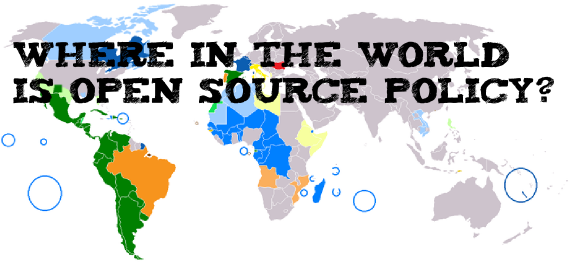Student project: where in the world is open source policy?
Max and I were talking with Michael Tiemann last week when he brought up a project he'd love to see some students work on.
The a "public policy research institution dedicated to analysis and policy impact," has just published a document on open
source policies.
The survey tracks governmental policies on the use of open source software as reported in the press or other media... The data in this report provides a snapshot of the current state of government open source policy. We divided open source policies into four categories: research, mandates (where the use of open source software is required), preferences (where the use of open source software is given preference, but not mandated), and advisory (where the use of open source software is permitted). We also looked at whether an initiative was made at the national, regional, or local level, and whether it was accepted, under consideration, or rejected. The study has found a total of three hundred and sixty-four open source policy initiatives. --"Government Open Source Policies," March 2010

Image based on a public domain map of Romance languages in the world from Wikimedia Commons by user Qyd.
It's 66 pages of graphs and tables, and there's some fascinating information buried in there:
- "The government of Brazil says it will switch 300,000 government computers from Microsoft's Windows operating system to open source software like Linux... President Luiz Inacio Lula da Silva is studying a draft decree which, if approved, would make [OSS] compulsory for federal departments." (page 7)
- "The Department [of Information Technology in India] is supporting the development of a Hindi Linux distribution, Indix." (page 15)
- "The Polish Ministry of National Education is advising schools and universities to use Open Source software. The recommendation comes at the end of a volunteer campaign to help schools switch to Open Source." (page 20)
- "The City of Vancouver, when replacing existing software or considering new applications, will place open source software on an equal footing with commercial systems." (page 31)
- "All students and teachers at the elementary school in the municipality of Tønder [Denmark] were given a 1 Gbyte USB key pre-loaded with open source applications last week. The municipality as a matter of principle says it will use open source when possible..." (page 31)
- "An act [in New York State] to amend the tax law, in relation to providing a tax credit to individuals for up to two hundred dollars of expenses related to the development and posting of an open source or free license program." (page 37)
What would happen, Tiemann asked, if someone pulled this into a map mashup? Behold,
the power of the map to explain complex data. What if a class of students, or an independent study, were to go all informatics-ninja on this, threw the data across several world maps, and applied some Edward Tufte visual design love and made these maps manipulable and interactive, like Gapminder? "Hey, this is what it looks like in Brazil. Here's what Chile is working on. Here's Japan."
Interested? Our community team at Red Hat can offer guidance and help any completed work make its way out there into the world. Leave a comment if you're interested, with a way for us to get in touch with you, or contact me directly and I'll make sure the right people get your message.